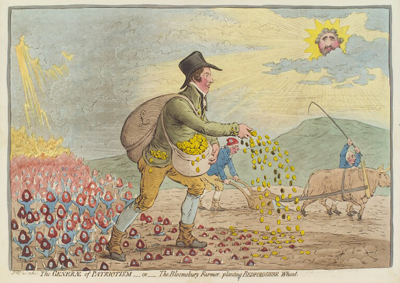The Generae of Patriotism. . .
The Whig leader, Charles James Fox, beams down his approval upon his friends and fellow Whigs working the fields together to produce a new crop of revolutionaries. James Maitland, Earl of Lauderdale, wields the whip; Richard Brinsley Sheridan (wearing the revolutionary bonnet rouge) drives the plow; and (most conspicuously) Francis Russell, Duke of Bedford, uses his vast wealth to sow the seeds of discontent and produce pro-French warriors armed with daggers. But on the far left storm clouds have gathered and lightning in the form of a (ministerial?) trident is striking the revolutionary crop almost as soon as it appears.

© National Portrait Gallery, London
The context for Gillray's print is complex and multi-layered. By early 1796, Britain had fallen on distinctly hard times. Bad weather in recent years had affected both the planting and harvesting of wheat; the cost of flour had nearly doubled, and much of the wheat produced was being bought by the government to support troops fighting the French abroad. People were literally starving.
In Gillray's The Republican Attack, published in November 1795, the banners carried by protesters had sigificantly read "Peace and Bread." For Gillray's audience, then, the link between failures in wheat production and the increase of revolutionary activity was more than a metaphor. It was a reality. And ever since Edmund's Burke's dramatic (some might say histrionic) speech in the House of Commons, arguing that "where French principles are introduced, you must prepare your hearts for French daggers," daggers had become a symbol of a growing French threat to British institutions.
At the same time, the Tory ministry was cracking down on free speech. Following hard upon the attack upon the King's carriage in November 1795, the Seditious Meetings Act and the Treasonable and Seditious Practices Act were approved by Parliament in December limiting the size of assemblies critical of the government and forbidding correspondence with French revolutionary societies. Gillray had himself been arrrested just a week before this print appeared for a most unlikely print, The Presentation, or the Wise Men's Offering on religious grounds.
The opposition to these and other restrictions in free speech was led in the House of Commons by Fox and Sheridan, and, in the House of Lords, by Lauderdale and Bedford, so it is not suprising to find all four of them working together in this print. But though Gillray, as a practicing caricaturist) would have been sympathetic with arguments for an unrestricted press, his dislike of Fox was consistent and long-standing. And ever since the execution of the French King, Gillray had mostly followed Burke in thinking that the spread of French principles was tantamount to supporting a revolution in England.
The focus in this print on the Duke of Bedford stems from reports that he was now using his vast wealth derived from his ownership and development of vast swaths of Bloomsbury to support Whig interests. But it is also owing to his reputation as an avid experimenter at his model farm in Bedfordshire in the latest farming and breeding methods. See, for instance, Gillray's later portrait caricature, Fat Cattle. Though there is no explicit allusion in the print to classical or Biblical slources, Gillray would not have been ignorant of the line from Galatians, " for whatsoever a man soweth, that shall he also reap," nor its applicability to the Duke. For to the extent that the revolution succeeded, the class of men like Bedford would surely have been eliminated.
Sources and Reading
- Commentary from the British Museum on The Generae of Patriotism. . .
- "Francis Russell, 5th Duke of Bedford," Wikipedia
- "The History of the Bloomsbury Estate" The Bedford Estates
- Thomas Wright and R.H. Evans, Historical and Descriptive Account of the Caricatures of James Gillray #147
Comments & Corrections
NOTE: Comments and/or corrections are always appreciated. To make that easier, I have included a form below that you can use. I promise never to share any of the info provided without your express permission.